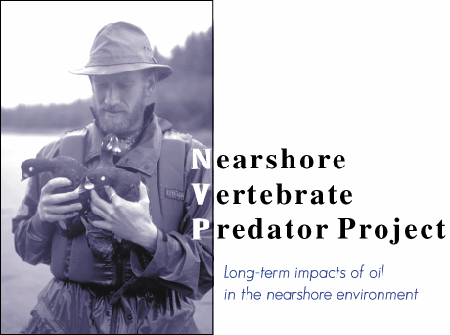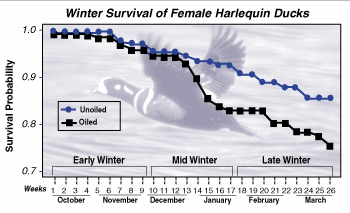
The plants and animals living along the coast took the brunt of the spilled oil as millions of gallons washed up along hundreds of miles of shoreline. Ten years later, some of the more heavily oiled areas remain polluted with tar, asphalt, and unweathered oil either at or just below the surface.
But what about the animals that live there? Of the eight species that remain listed as "not recovering" ten years after the spill, seven use the nearshore environment for nesting, feeding, and resting. Is it oil that is preventing their recovery or are other factors involved, such as food availability, reproductive ability, weather, or predation? How long does it take for populations to rebuild to pre-spill levels?
This central question became the basis of the Nearshore Vertebrate Predator project, a six-year $6.5 million effort conducted by the Alaska Biological Science Center of the U.S. Geological Survey in cooperation with scientists from NOAA and the University of Alaska Fairbanks. This team of scientists sought answers to the fundamental question about oil spills: how long does oil persist in the environment and does it continue to impact wildlife?
Researchers narrowed their study to four species injured by the spill: two fish eaters (river otters and pigeon guillemots) and two species that feed on shellfish (sea otters and harlequin ducks). All four species are long-lived and spend most of their time in the nearshore environment.
All four species could face oil contamination in the nearshore waters whenever oil in sediments is released. Other potential avenues of oil exposure, through diet or direct contact, differ for each species. Sea otters, which feed on shellfish and dig through large volumes of sediments where residual oil persists, are likely to contact oil while foraging or through their diet. River otters, which catch fish for food, are more likely to be exposed on shore. Pigeon guillemots would have minimal direct exposure to oil, although they do supplement their diets with invertebrates. Harlequin ducks, on the other hand, live on shore and feed on shellfish and could be exposed to oil through preening and diet.
The risk of oil exposure is greater for animals that eat invertebrates, such as clams and mussels, because they concentrate hydrocarbons. Fish, on the other hand, metabolize hydrocarbons quickly and, thus, don't concentrate them.
The NVP research team split up into groups studying each of the four species. They maintained two research sites, one in an area that was heavily oiled in 1989 and the other in an area that saw very little or no oil. In this way they could compare results from oiled areas to non-oiled areas.
Animals were captured, weighed, measured, aged, and had blood samples taken. Before being released some harlequin ducks and river otters had transmitters attached to allow researchers to follow their movements and to indicate death (should that occur).
The results differed between regions and among species. Harlequin ducks showed signs of continued stress, and populations in the oiled areas had zero growth. Sea otters in the most heavily oiled areas of northern Knight Island have not increased in abundance, despite food supplies capable of supporting population growth. There has, however, been an increase in numbers of sea otters in the comparison group.
Female harlequin ducks in the oiled areas were less likely to survive the winter than those from non-oiled areas (Figure 1). Although the difference was not great (78 percent survival versus 84 percent survival), it is enough to have a significant impact on the population. Researchers calculated that the winter survival rate in oiled areas was enough to cause a 5 percent population decline versus approximately stable populations in the unoiled areas. Survey data are consistent with these data on survival.

Researchers used a biomarker of hydrocarbon exposure to determine whether animals in the oiled area were still being exposed to oil. Based on analysis of blood and tissue samples, both species showed evidence of recent exposure to oil. Researchers say, however, that the exposure appears to be variable, and there is some indication that it is diminishing each year.
For the harlequins, ducks with the highest levels of the biomarker tended to have the lowest body weights, suggesting that oil exposure was negatively affecting their health. In contrast, sea otters from the oiled study area tended to be in better condition than their counterparts in the nonoiled area, perhaps because of greater availability of food, given the low numbers of otters there. However, over the last decade, blood work on sea otters has indicated liver damage in animals residing in the oiled areas, which may be a result of exposure to the oil.
By the end of the NVP study, researchers determined that only a small proportion of the sea otters still exhibited abnormal blood values, which is consistent with declining amounts of residual oil in the environment. It is also important to note that both sea otters and harlequin duck populations appear to be healthy or stable when considering the entire Prince William Sound. Effects of continued exposure to oil are seen primarily in more heavily oiled regions in the western part of the sound.
A colony of pigeon guillemots at Naked Island is not rebounding from the impacts of the oil spill, and apparently, both oil and food availability may be affecting recovery. The Jackpot Bay colony is growing dramatically, whereas the Naked Island colony remains depressed. Based on biomarker results, pigeon guillemots at Naked Island continue to be exposed to oil, although perhaps at relatively low levels. However, blood work on birds from the Naked Island colony suggests that oil may be affecting the function of liver and other organs. Recovery of the guillemots may also be complicated by diet differences: birds at the healthy Jackpot colony eat twice as much herring and other high-energy fish as do those at the Naked Island colony. A major shift in forage fish (see APEX) has impacted many species and colonies throughout the Gulf of Alaska region. The food available to Naked Island guillemots consisted mostly of pollock and cod, which has about half the amount of fat as herring.
In following the trail of river otters, NVP researchers were able to determine that the river otter had recovered from the effects of the spill. Biomarker levels were higher in river otters from the oiled area in 1996, the initial year of the study, but by 1998, no differences were seen between animals in oiled and nonoiled areas. Other measures of health, which indicated that river otters suffered from oil effects in the early 1990's, had also returned to normal by the time of the NVP study. In 1999, the Trustee Council officially declared the river otter "recovered."
The NVP research team concluded in 1999 that continued oil exposure appears to be through a diet of invertebrates and, possibly, by grooming or preening. This can come from mussels left untreated after the oil spill or other intertidal and subtidal invertebrates from the sound's floor. Oil on shorelines or in the nearshore water column may also be a source of contamination, getting onto an animal's fur or feathers.
"The collective evidence supports the hypothesis that patchy, persistent oil in the sound is still being sufficiently mobilized some 10 years post-spill to constrain recovery within the nearshore ecosystem," the NVP final report concludes.
"It is apparent that we are no longer studying populations under acute stress, but rather that components of the invertebrate-based nearshore community are still under chronic, but decreasing levels of stress. This stress is observed not at a regional level where both sea otters and harlequin duck populations are stable or growing, but in those areas of the sound most heavily oiled by the 1989 Exxon Valdez oil spill and examined under the NVP study."
For more information on the NVP Project, please click HERE.
